Victor Arden was born, in theory and in name, a lot later than the man who actually created him as a pseudonym, Lewis John Fuiks. The only son of Samuel Fuiks and Vallie Worley, both Illinois natives, Lewis was born and raised, for a time, in Wenona, Illinois, not far from Peoria. His father was listed in the 1900 enumeration as working in "general merchandise," likely managing or owning a general store of some kind. Not much has been reported about Lewis' early musical training, but there was probably some piano instruction involved, along with harmony and theory. As evidence of this, Fuiks was able to publish a rag at age 16 in Chicago with the unusual title of Safety Pin Catch. By the time of the 1910 census the family had moved to Chicago, where they were erroneously enumerated as the "Fox" family. Samuel was shown to be working in a clothing store as an assistant buyer.

In the fall of 1910 Lewis was enrolled in the University of Chicago, and he emerged with a degree in music in short order. This was followed by training at the American Conservatory of Music, also in the "windy city." There is some possibility that Fuiks was producing piano rolls as early as 1915, likely in Chicago. There are some roll titles that were released by Imperial, a Chicago company, in the mid to late 1910s. In their advertisements of 1916 they promote Fuiks as "the Chicago University Musical Wonder." He and fellow dynamo performer Zema Randale were considered the primary "raggists" of the Imperial label. In a Music Trade Review notice in the October 7, 1916 edition, it was noted that: "...the Jazz-Ragger Fuiks and the inimitable syncopating star, Zema Randale, are coming under the protection of insurance companies. The Imperial Co. sells its high-grade products at such fair prices that it will not subject itself to loss through the inability of any of its staff to play."
Yet Imperial did suffer that very loss shortly thereafter as Lewis moved on to greener pastures. To compound things, their other star, Miss Randale, tragically died in 1918. It is not known for certain when Fuiks moved to New York City, but given that his first output from there came in 1917, and he is known to have contributed at least four "operas" to the Chicago Blackfriars, the last presented at their annual musical in May of 1916, he likely left for Manhattan late in 1916, along with his new wife Ilse Spindler.
One of Fuiks' first jobs in New York may have been as an accompanist for the movies and, given his training, for hire by singers as well. However by February 1917 he was arranging and recording piano rolls as his primary career. There was some output from the Rythmodik roll company in 1917 through 1919, including his own Honeymoon Waltz which was considered somewhat of a hit. However, the bulk of Fuiks' early works were on the Ampico label, the parent company of Rythmodik, turning out "hand-played" expression rolls of popular dance tunes, tangos, and operettas. When the Rythmodik label was finally abandoned many of his cut were re-released on Ampico rolls. Early advertisements for both labels touted him as a jazz artist.
While about two dozen of these were printed under his given name of Lewis J. Fuiks, this may have proved problematic to either Lewis or Ampico management for obvious linguistic reasons (this has not been officially established in fact but has been discussed), and he was soon rechristened as Victor Arden on his popular jazz rolls as early as February, 1917.
Even though Lewis still used his given name for legal purposes, Arden would be the name he was professionally known as for the rest of his life, although rolls played by Fuiks were still shown in the listings as late as 1929. In at least one 1920 advertisement, both names are listed, a matter of continuity and removing the necessity to relabel all of the older rolls with the artist's new name. His 1917 draft record, taken in New York City, shows him working for the American Piano Company (Ampico) as a musician, with an address north of the city in Yonkers.
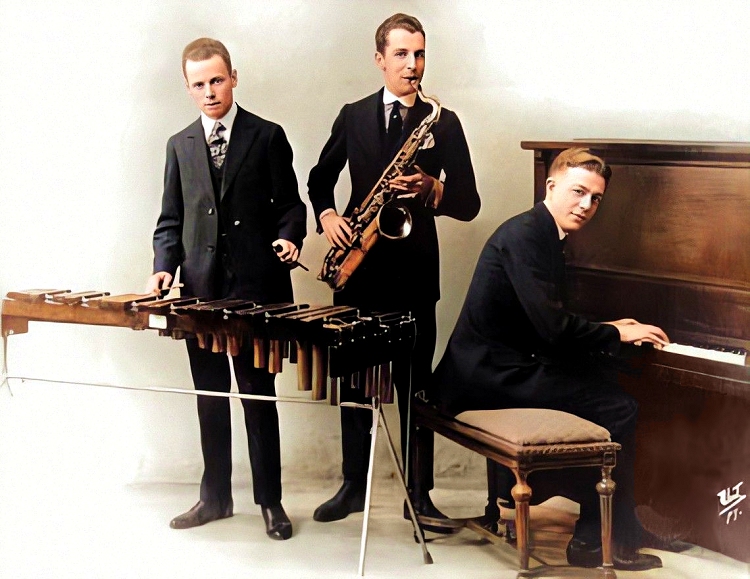 |
Starting around 1918, Victor formed a group called the All Star Trio, with F. Wheeler Wadsworth on saxophone and George Hamilton Green on the newly-minted vibraphone and other tuned percussion. They recorded for the next two years on the Edison label initially, turning out recordings for Victor, Brunswick, Pathé, Okeh, Paramount, Emerson, and for the Vocalian label of Aeolian, a subsidiary of the American Piano Company. Fellow pianist and roll arranger Max Kortlander stepped in for Arden on occasion. Arden also continued to turn out great rolls of popular tunes during this time, earning him the title of King of the Piano Roll. The bulk of Victor's compositions were from this period. In either June or July of 1918 Arden shifted gears and labels as he started arranging and playing for QRS, the dominant standard roll manufacturer.
It was at QRS that Victor first met pianist Fillmore (Phil) Ohman, who had been there for a couple of years. They found that they had similar backgrounds, abilities and points of view concerning performance, and neither lacked the energy to explore new ways to interpret tunes. The duo quickly found that they could produce some amazing roll arrangements with little effort, and were soon inseparable. Their first QRS rolls started to appear within weeks of Arden joining the firm. Ohman sketched out the general direction of what they would play without full notation, then they would record with Arden in the bass and Ohman in the treble.
One critic who observed them up close found Ohman to be the "wag and clown of the pair," calling Arden the "serious minded, painstaking musician." While a slightly imbalanced point of view, Ohman's humor was more likely to come out in his playing, even during serious classical recitals that he accompanied. Both quickly became celebrities both in and outside the circle of jazz performers, and the public proved to be thirsty for their duet piano rolls. Lewis is listed in the 1920 census as a "musician recorder" living in Yonkers with Ilse, and a new addition, Lewis John Fuiks Jr., born in July of 1919. Son Robert Spindler Fuiks would follow in 1921.
While Arden and Ohman continued to make rolls both together and separately, Phil, through praise brought for his public performances, was offered a job in the fast-rising orchestra of Paul Whiteman, the so-called "King of Jazz." Not able to keep all his various positions, Ohman had to quit QRS and break up the duo for a while. Victor would continue to do duets through the mid-1920s, but with Kortlander, who he had been playing with since joining QRS, filling in for Ohman. Victor also kept busy with outside obligations.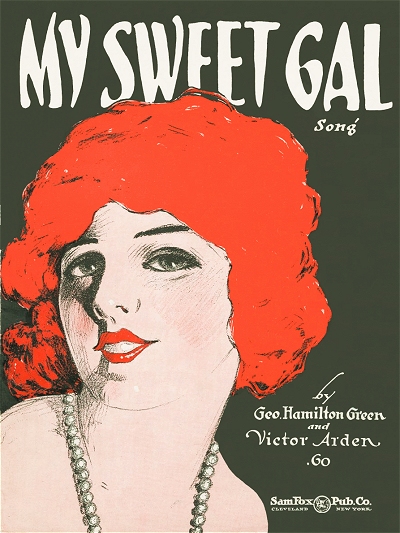 The All Star Trio expanded from 1921 to 1922 as the All Star Trio with Orchestra, featuring the distinctive Billy Murray on vocals. They signed a contract with the B.F. Keith Vaudeville Circuit for a 1922 tour.
The All Star Trio expanded from 1921 to 1922 as the All Star Trio with Orchestra, featuring the distinctive Billy Murray on vocals. They signed a contract with the B.F. Keith Vaudeville Circuit for a 1922 tour.
 The All Star Trio expanded from 1921 to 1922 as the All Star Trio with Orchestra, featuring the distinctive Billy Murray on vocals. They signed a contract with the B.F. Keith Vaudeville Circuit for a 1922 tour.
The All Star Trio expanded from 1921 to 1922 as the All Star Trio with Orchestra, featuring the distinctive Billy Murray on vocals. They signed a contract with the B.F. Keith Vaudeville Circuit for a 1922 tour. While the job with Whiteman was both good for his exposure as well as making connections, Ohman realized, as did Arden, that it was less fulfilling than their duo performances. So after a year or so he quit Whiteman's orchestra and concentrated on local gigs with Arden. They built their repertoire playing in clubs in midtown Manhattan, particularly on 52nd Street, and finally went into the studio late in 1923 to record live as a duo. Among their eclectic choices were the 1888 galop Dance of the Demons by multi-piano composer Eduard Holst, and two popular piano rags, Maple Leaf Rag and the song version of Canadian Capers. They were also one of the earliest piano duos to appear on radio as early as 1922, and were featured in one notable broadcast on wireless Chicago station KYW on April 11, 1925, for an estimated audience of 300,000 listeners. Phil had further exposure on the popular Roxy and His Gang Show which was broadcast from the Capitol theater where Ohman had worked. He brought Arden on for occasional appearances on the show.
The performances were a sensation, and Broadway soon discovered them as well, knowing that they would be an additional draw to certain shows. The use of dual pianists or pianos was not new on Broadway, but their reputation was about as solid as their first Broadway employer/collaborator, Gershwin himself. So it was that they co-led the pit orchestra for Lady Be Good in 1924. According to the January 3, 1925 edition of The Music Trade Review:
An interesting anecdote relative to the two Story & Clark small grands being used by Phil Ohman and Victor Arden in the musical show 'Lady Be Good,'... was told this week by L. Schoenewald, New York district manager of the Story & Clark Piano Co. 'The original arrangement was that two of our pianos were to be used by the show when it opened in Philadelphia... but an error on the part of the stage carpenters resulted in building of the special moving platform too small to hold them. Although they had requested Story & Clark grands, Ohman and Arden were compelled to play their duet numbers on two 4 feet 8 grands of different makes during the Philadelphia engagement. They were not satisfied with the tone of these pianos, so on coming to New York Victor Arden prevailed on the management to enlarge the platform to hold our 5 feet 2 inch grands. It has afforded the Story & Clark Piano Co. much pleasure to realize that our pianos are held in such esteem by two such talented pianists as Phil Ohman and Victor Arden.
Gershwin started what would become a popular trend throughout the remainder of the 1920s and into the 1930s, supported in the end by the economy of having two pianists and requiring less orchestra personnel. This trend was noted in The Music Trade Review of July 16, 1927, in the following excerpt:
Piano Duos Featured in Both Productions and Over the Radio as Well as in Moving Picture Theatres—Wide Variety of Effects Obtainable
A FORM of presentation of popular numbers which during the past season has reached a new point of popularity is the piano duo as exemplified by nearly half a dozen teams of pianists featured in the orchestra pits of the leading musical comedy successes. The use of specially arranged numbers for four hands is a practice older than jazz itself and originated many years ago in the recording studios of the pioneers in music roll making. Since that time, with the development of the augmented dance orchestra, the employment of two pianos has followed the trend of the day and the sparkle of special choruses for the pianists in skillful teamwork has become one of the bright spots of an evening at the dance floor or cabaret.
About three years ago Phil Ohman and Victor Arden, seasoned recording pianists, were featured in a specialty in "Lady, Be Good," a George Gershwin musical show. This started things for the theatrical presentation of piano duos and the same team appeared the following year in the pit of the Gershwin show, "Tip Toes." Here the effect was more impressive than in the previous engagement, where they had appeared on the stage but only for a short time. In the second show the two pianos were an integral part of the orchestra during the entire evening.
Anyone susceptible at all to rhythmic and harmonic effects in popular music will not soon forget the thrill of hearing the arpeggio passages of Phil Ohman on the upper register of his piano in the number, "That Certain Feeling," of Gershwin. The pianists had carefully gone over the entire score with the composer in rehearsals and every place that afforded a pianistic "break" or embellishment was so treated. The result was a score far more brilliant and individual than is customarily heard from the orchestra pit and a new custom was started...
But the spread of popularity of the piano due has not ended in the theatre. The radio, too, has developed favorites in four-hand interpretation of the latest hits.
Phil Ohman moved from QRS to Aeolian in July, 1925, to cut Duo-Art rolls, effectively ending the six year run of QRS duets he had done with Arden. However, it was not the end of their partnership by any means. Their first Broadway success would be followed by more Gershwin shows such as Tip Toes in 1925, Oh, Kay in 1926, and Funny Face in 1927. Other shows included Treasure Girl in 1928, both Spring is Here and Heads Up in 1929.
In between the Broadway shows they recorded and performed on the road on the vaudeville circuits. Among the labels Ohman and Arden appeared on were Brunswick, Columbia, Victor (soon to be RCA Victor) and Gramophone.
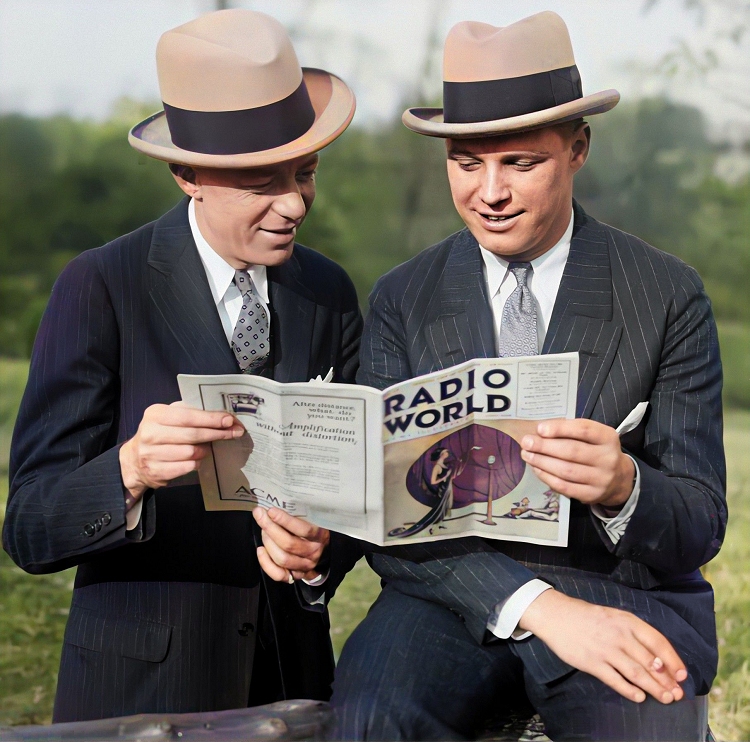 |
During this period, while Arden and Ohman were under contract to Brunswick Records from 1923 to 1927, they were involved with that company's transition from acoustic to electrically-recorded discs in 1925. As a result, several of their tracks, as well as many done by Phil accompanying other musicians and singers, were done with both acoustic horns and then microphones in the same session, and others required three or four sessions over as many months to render satisfactory results. Brunswick master logs show at least four attempts at the disc containing Operatic Favorites and Waltzes of the Past between May and August 1925, possibly due to issues with properly capturing not only the pianos, but also the xylophone of George Hamilton Green who was playing with them. By late 1925 all of Brunswick's releases, as well as most by other record companies, were electrically recorded.
It should be noted that when Victor and Phil were billed in any venue that the order of their names did not matter to them, the sign of a solid partnership. They were also sought out in the late 1920s, as many New York acts were, by Warner Brothers for a few Vitaphone sound shorts, one of the first being The Piano Dualists in 1927. They were later seen and heard playing Dancing the Devil Away in the 1930 RKO musical The Cuckoos. Arden turned out many interesting arrangements during the 1920s of dance tunes on record, many sold very cheaply in Woolworths and similar outlets, making his name perhaps even better known than Ohman's.
One of their contemporary critics, Gay Stevens, said the following concerning this formidable duo:
There is not a piano player in the land who, after hearing Ohman and Arden interpret a piece of jazz music on their two pianos, has not wanted to throw his piano out of the window. The keyboard magic of this duo-team has been the inspiration and despair of every real American youngster who sedulously practiced his Czerny with a secret desire to win excited gasps of admiration from the fair young things in his circle by his jazz piano playing.
Arden, Ohman and Kortlander appeared together often for QRS promotions in the mid-1920s, playing live performances of their collective solo and duet piano rolls in addition the occasional trio.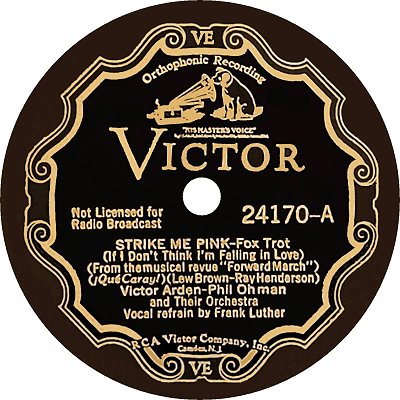 While Victor and Phil often performed just with the piano, the Arden-Ohman orchestra was started in 1925, initially for recording but later for both live performance and radio work. It was the latter that gave them their best overall exposure in the late 1920s through the first part of the Great Depression.
While Victor and Phil often performed just with the piano, the Arden-Ohman orchestra was started in 1925, initially for recording but later for both live performance and radio work. It was the latter that gave them their best overall exposure in the late 1920s through the first part of the Great Depression.
 While Victor and Phil often performed just with the piano, the Arden-Ohman orchestra was started in 1925, initially for recording but later for both live performance and radio work. It was the latter that gave them their best overall exposure in the late 1920s through the first part of the Great Depression.
While Victor and Phil often performed just with the piano, the Arden-Ohman orchestra was started in 1925, initially for recording but later for both live performance and radio work. It was the latter that gave them their best overall exposure in the late 1920s through the first part of the Great Depression.In addition to this live duo, Arden went back to work for Ampico in the spring of 1928, turning out new popular roll arrangements. As announced in The Music Trade Review of February 11, 1928: "J. Milton Delcamp, vice-president of the Ampico Corp., announces that arrangements have been made with Victor Arden, the well-known young American pianist and devotee of popular music to record his playing exclusively for Ampico records [rolls] in the future. Mr. Arden, a graduate of the University of Chicago and of the American Conservatory of Music of that city, came to New York several years ago, and in company with Phil Ohman has played in a number of musical comedy successes and has also been a member of Roxy's Gang." This job soon expanded into a series of duets with Ampico roll artist Adam Carroll. Carroll subsequently briefly joined Arden and Ohman to create a piano trio for a few performances on radio and for special functions.
From 1928 to the mid-1930s, Arden and Carroll turned out over 60 rolls with their names on them. However, while some may have been arranged initially by Arden, many were filled in (and some created) by Frank Milne at the factory (often edited with colored pencils on Milne's kitchen table). They are still often considered to at least be in the style of Arden and Carroll, even if not entirely played by them. Both turned out rolls separately as well, but the player piano business faded fairly quickly as the Great Depression set in and free entertainment was available via radio. When Ampico failed in the late 1930s many of these rolls were re-coded for Duo-Art performances, making them among the rarer rolls that were available for both reproducing systems. As of the 1930 census Lewis and Ilse were still living in Yonkers with their sons Lewis and John and one servant, and Lewis Sr. was listed as a musician/performer.
Realizing that the best possible future for success was on the radio, the most effective medium of the 1930s, the dynamic piano duo re-teamed and hit the airwaves. Arden and Ohman had no issue finding good sponsorship, playing for everything from news programs to two or three numbers advertising toothpaste or fine watches.
Some of their musical shows included The Bayer Music Review, The Buick Program, and the landmark American Album of Familiar Music. But the stresses of performance partnership eventually interfered, more on the professional level than on the personal level, and in 1934 Arden and Ohman split to go in different directions, remaining friends. The duo reunited for one more recording session on Brunswick That same year. Ilse Fuiks had her own hobby as well, dabbling in the world of equestrian competitions. She owned a few different horses during the 1930s, including one fine jumper named Happy Days.
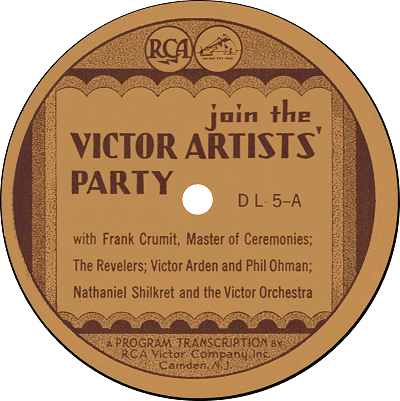 |
While Ohman went on to some fame in Hollywood, Arden chose to stay back east where radio was still the predominant form of entertainment during the waning days of the Great Depression. He was able to secure work as both pianist and conductor on NBC (National Broadcasting System), including such shows as Kings of Melody, Sweetest Love Songs Ever and Broadway Varieties. Arden also worked and recorded with his own dance band, but with all the other engagements he had to keep it fizzled out before too long. He also filled in for leader Abe Lyman on many occasions, conducting for his popular Waltz Time shows. Arden enjoyed one last stretch on Broadway playing for the revue George White's Scandals of 1939.
Lewis and Ilse and their sons were still living in Yonkers in 1940 for the enumeration, along with one servant, although father and oldest son listed themselves as John L. instead of Lewis J. For his "Victor" side he listed himself as a musician for "own orchestra & for others." In 1944 their younger son, Lieutenant Robert Fuiks, USNR, was first engaged to Thirsa Burr Sands that October. In the 1940s during World War II, Lewis continued to make records with various orchestras as Victor Arden, and was featured on the Manhattan Merry-Go-Round for a while in 1947, eventually landing steady spot on The American Melody Hour near the end of the decade. The 1950 census, taken in Yonkers, New York, showed Arden as a radio musician. In the 1950s Arden again led an orchestra, this time behind the charismatic Dick Powell, the singing star of many MGM movies. One of his last projects was a reincarnation of his first group, the All Star Trio, after which he went into retirement. He had moved from Yonkers in 1951, buying an apartment at Douglas Park, located at W. 236th Street and Henry Hudson Parkway in Riverdale.
Lewis was remarried in the 1950s to Frances Newsom. During his last few years the couple lived at 77 Park Avenue in Manhattan. His former partner Phil Ohman died in the summer of 1954. Lewis Fuiks a.k.a. Victor Arden died almost exactly eight years later in 1962 at age 69 leaving behind a wealth of recordings allowing us a look into some of the most exciting music of the 1920s and 1930s. His work both alone and with Ohman brought a certain vitality to the driving rhythms and languid ballads of the 1920s and beyond, making the player piano a glamorous instrument, and its listeners always wanting more.
Thanks to New Zealand piano roll historian Robert Perry for additional information and clarification on Arden's career with various piano roll companies, and for the Gay Stevens quote. For more on piano roll artists, please visit him at www.pianola.co.nz. The remaining information was researched by the author in public records, periodicals and recorded media.


 Compositions
Compositions